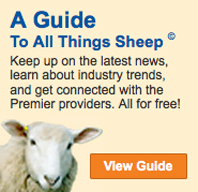
DOCKING & CASTRATING
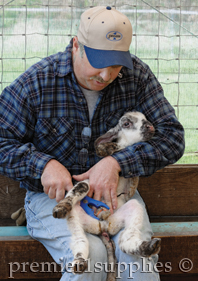
Premier Shepherd Carl using an O Ring Expander to castrate a new born lamb. The majority of ram lambs at Premier are castrated (made into wethers), though a few with breeding potential are left intact.
Materials and Methods
Expanders & “O” Rings
An expander stretches the latex rubber ring(s) open to allow sliding it over a tail or scrotum. When released, the ring(s) clamps the arteries shut. The tail or scrotum usually drops off in 7 to 14 days.
Rings (from all sources) occasionally break so it’s wise to either:
| 1. |
Check results a week later and re-ring as needed. |
| 2. |
Apply 2 rings instead of one. Rings are less than 2¢ so it’s cheap insurance. We put 2 rings on all pasture-born lambs because lambs are older (so may have thicker tails) and we don’t want to bring the flock in a second time. |
Though the ring method is proven by tests to cause more animal distress than a knife or emasculator, the pain lasts less than 30 minutes if lambs are less than 7 days old.
Advantages of ring method:
| • |
No method is simpler or quicker. |
| • |
Rings and expander are not expensive. |
| • |
Tool/rings fit into pockets or tool boxes. |
| • |
Fly-strike is less likely (no blood). |
Issues of ring method:
| 1. |
With lambs and kids it can be difficult to get both testicles below the ring because the testicles are small. |
| 2. |
Applying rings before a lamb or kid is 24 hours old, up on its feet, nursing and active may interrupt nursing and so pre-dispose lamb to death from E. coli problems (“watery mouth”). That’s why we wait 2 days to use them on twins, triplets and orphans. |
| 3. |
Rings may make a lamb vulnerable to tetanus. Vaccinate all ewes or does for this prior to lambing or kidding. |
Double Crush Tail Docker
Crushes the arteries before severing them cleanly which minimizes risk of serious bleeding. Works on lambs up to 70 days of age. During fly and gnat season apply a fly repellent (such as Pine Tar or Catron IV) to the cut.
Advantages:
| • |
Blood loss is minimal because blood vessels are crushed before they are cut. |
| • |
Immediate stress on the lamb is less than with the rubber rings. |
Emasculatome
Crushes the spermatic cords. Does not cut skin of scrotum, thus no blood and less risk of fly-strike. Testicles dry up; scrotum shrinks within 21 days. Never clamp the entire scrotum with a single squeeze. Never allow the opposing marks (on each side) to meet.
Advantages:
| • |
Strong, precise action. |
| • |
Will castrate lambs up to age 90 days. |
| • |
Same action as Side Crusher. |
Side Crusher Emasculatome
Unique design allows side access to scrotum to crush spermatic cord—thus enables better vision and access for smaller lambs/kids.
High quality precise tool that’s made specifically for Premier.
Advantages:
| • |
More user-friendly tool than normal Emasculatome. |
| • |
Smaller jaws reduce scrotum injury risks. |
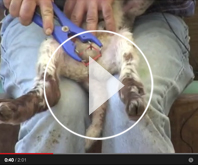
Premier Shepherd Carl demonstrates how to dock and castrate a recently born lamb.
FEEDERS
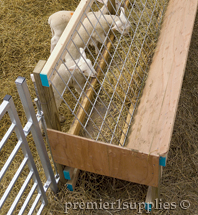
Single-sided feeders built low enough to allow lambs/kids to access feed. This design works well for feeding along an alley or walkway.
Why our Build Your Own Feeders please users…
| • |
Minimal waste—The panels prevent silage or hay from being pulled into the pen and onto the ground. Goats and sheep must work for each mouthful. |
| • |
Less risk of injury—Entering the pen is not required—so even children can safely feed hay and/or grain. |
| • |
Grain, silage and hay can all be fed in this feeder—Saves space and reduces cost. |
| • |
Save $$—Make your own feeders and use local lumber to do so. |
| • |
Proven—They have been in use across the nation for years—and are now even copied by our competitors, which is the ultimate compliment. Of course, we’ve tweaked and improved the design along the way. (That’s who we are.) |
How-to Instructions:
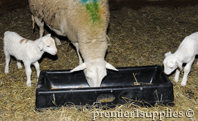
PortaTrough being used to feed supplement to lactating ewe. Trough is durable enough to handle ewes and energetic lambs.
PortaTrough™ key benefits…
| • |
Strong, tough and durable. |
| • |
Economical. |
| • |
Difficult for sheep or goats to tip over. |
| • |
They stack inside each other for easy movement and storage—up to 10 PortaTroughs per stack. |
| • |
Easy to stack and carry on ATVs. |
| • |
Side hole allows trough to be inverted with a toe to tip out water or ice. |
| • |
Won’t break if ice forms in them due to their rounded inner base. |
| • |
Deliverable by UPS/FedEx, etc. |
|
 |
 |
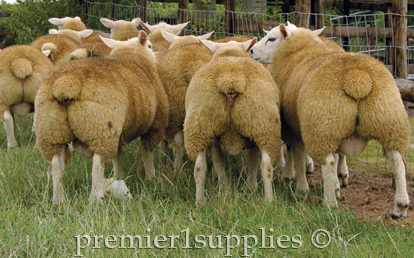
Terminal sires with "bubble butts".
What is the future for US lamb?
It depends. Given the dramatic rise in lamb prices and drop in feed costs since the summer, some might say the future is good.
The correct answer is more complex. Prices are just as likely to drop again.
The good news:
| • |
The lamb price rise and the drop in forage and grain prices has stopped much of the financial bleeding of producers. |
| • |
US lambs being killed in the major slaughter plants are less likely to be overweight and/or too old to be considered prime lamb by some consumers. Average carcass size has dropped from over 75 lbs to 65 lbs (over 150 lbs live weight to 130 lbs). So consumer acceptance is likely to be higher. |
| • |
There is a wider acceptance of the view that some US lamb has serious quality issues. To illustrate: I attempted to make this point in August 2011 at an American Lamb Board meeting in Denver while the board was working on its long term plans. Only 2 of the other 11 board members agreed me. Now, however, many industry leaders appear to also think we have quality issues, as evidenced by the Hale report. |
| • |
ASI's Lamb Council is seeking a new name for older lamb. The effort has encountered opposition by those whose pocketbooks and production systems would be negatively affected—understandably. Nonetheless I think a change in name would be an important improvement. |
| • |
The new CEO of a major US lamb packer appears, from his recent comments, truly to understand how important consistency and quality are to their lamb brands. |
The bad news:
| • |
US lamb costs considerably more per lb or per serving than competing animal proteins (beef, pork, chicken, fish). |
| • |
Imported lamb now "owns" over 50% of the US lamb market. |
| • |
US lamb is more variable than imported lamb. This is bad because consistency is a major part of perceived quality. Evidence? Recent ALB (American Lamb Board) consumer focus groups reported serious frustration that USA lamb tastes different from one shopping experience to another—even when buying from the same retailer or food service company. |
| • |
US lamb continues to be more expensive than imported lamb per lb and per cut (particularly per cut because a lamb chop/cutlet/rack/leg from a 65 lb carcass (typical US lamb) is 33% heavier than a lamb chop/cutlet/rack/leg from a 45-50 lb carcass (typical imported lamb). An item with 20% higher cost/lb and a 25% heavier (in weight) cut is an item that costs 50% more per cut. That explains much of the switch to imported lamb. |
My conclusions: If US lamb is to take back market share from imported lamb we need to:
| 1. |
Continue to produce as much of the heavier US lamb carcasses and cuts as the market will absorb. It's a unique product. But it must be made more consistent in age and size, be available year round, and cost less per lb. And overage carcasses need a new name. It confuses the market to have differing items sold under the same name. |
| 2. |
Encourage a larger US supply of well-muscled, young, 90-110 lbs live weight lambs that can compete directly with imported lamb in all 4 key aspects:
| • |
size |
| • |
consistency
|
| • |
cost
|
| • |
year round availability.
|
|
|
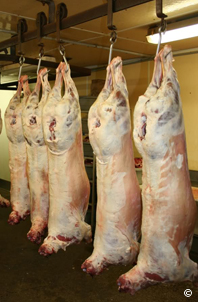
"These are Texel sired 6 month old lambs out of my Bluefaced Leicester X Clun Forest (Mule) ewes. These lambs represent what can be done in the upper Midwest with a forage only system utilizing the proper genetics. These lambs hang at ~ 25 to 27 Kg and they and their dams are forage only. Again the key is the genetic manipulation.
—Mark Lelli DVM, Michigan
|
|
| |
The most likely source for this is the 60,000 plus farm-flock producers. It's my sense that much of the variability of US lamb (save for age and fat) comes from these producers who raise them for the show ring, for fleece production and for personal, not primarily for profit reasons. This variability is an un-intended result in every instance—and occurs in large part because the marketplace does not provide sufficient incentive to reduce the variability due the wide array of breeds, crossbreeds and production systems. |
| |
| • |
Encourage farm-flock producers of all breeds to use well-muscled terminal sires from these breeds: Dorper, Texel, Ile de France, Shropshire, Dorsets. Hampshires, and Suffolks. In all instances the rams must be selected for "bubble-butts" (leg shape, see photo at beginning of these comments.) and large loin eyes per day of age—and not for the tallest and longest males. Remember the goal for lambs under point 2 above is 90-110 lb live weight lambs that will match up to imported lamb in shape and size and cost. |
| • |
Encourage seed stock producers to produce meat terminal sire rams that will thrive in large commercial flock situations. Seed-stock producers will do this if they are paid enough for their rams. |
| • |
Educate the vast number of small producers how to produce lambs of higher quality. Most of us (Premier is part of this group) take real pride in our product and therefore wish to produce the best lamb possible. I suggest we all need more information on how and how not to do so. |
|
| 3. |
Give all possible aid and support to producers who are, or would like to, market their lamb directly to consumers, restaurants and stores. |
I appreciate that some of the above views expressed here will upset some. For that I apologize in advance. Remember they are just my current views—and aren't written in stone. I'm open to anyone writing to me to upgrade my views.
Thanks folks,
Stan Potratz
Direct Marketing of Lamb Survey...
We encourage everyone to take the time to do this survey. Why? Because the American Lamb Board (ALB) has finally been persuaded toward supporting current and prospective direct marketers of lamb. I've long been an advocate for this.
How much support, and what form it takes, will depend in large part upon the results of this survey. I would like them to hire a full-time person whose task would be to learn as as much as possible about both direct marketing lamb and the ethnic markets — and, in turn, share the knowledge to the industry via brochures, emails, webinars, personal presentations to state and regional meetings.
But I won't be on the board after January—so if you wish this to occur I urge you to take this survey. And don't stop there. Contact ALB members by email and phone and share your thoughts directly.
—Stan Potratz
Do you Direct Market your Lamb?
The American Lamb Industry is attempting to take a closer look at the direct marketing of lamb across the United States. In an effort to better understand the current trends and assess the needs of this type of marketing, we ask those engaged in direct sales of lamb to complete the following survey. By combining the survey results, interviews and other research; we hope to formulate materials to assist you in your direct marketing pursuits.
Please click here to complete the survey before January 6, 2014.
Please help us spread the word by forwarding this information to fellow shepherds. If you would prefer; we would be happy to send you a hard copy of the survey. Please call 717-485-0532 to request a hard copy. Also, provide us with your contact information upon completion of the survey and be entered to win one of three prizes!
Thank you for taking the time to share your experiences and needs for the betterment of the Industry.
EXTENSION NEWS
Winter Livestock Management
Dr. Susan Kerr, WSU-Klickitat County Extension Director
Publish Date: Winter 2008, Vol. III No. 1
Rain, sleet, snow, ice, freezing temperatures—winter can be a real struggle for two- or four-legged animals. Those of us with two legs can generally put on a warmer coat or go inside to warm up with a cup of something hot, but what can livestock managers do to keep animals healthy and comfortable in winter?
WATER
The necessity of a clean and reliable year-round source of water cannot be overemphasized. Novice managers often mistakenly believe that animals can meet water requirements by eating snow or licking ice. With daily water requirements varying from three gallons (sheep) to 14 gallons (cattle), one can see that livestock would need to spend every waking hour eating snow to meet their requirements. Ice and snow consumption also lowers body temperature and increases maintenance energy needs, so it should be discouraged.
Water consumption is encouraged when water temperature is 37°F or above. Tank heaters may be required to ensure that water sources do not freeze. Be sure to follow manufacturers’ recommendations to prevent fires and electric shocks or electrocution of livestock. If heaters are not used, unfrozen water should be provided several times a day. Ensuring adequate water intake will encourage optimal health and performance of livestock and help prevent serious conditions such as colic and impaction.
ENERGY REQUIREMENTS
Livestock’s maintenance nutritional requirements can increase significantly during cold weather. Requirements increase dramatically if animals become wet and/or there is appreciable wind. Lowest critical environmental temperatures (LCT) for livestock vary according to species and researchers, but 20° or 32°F are often used as the lowest temperature dry livestock can tolerate without additional energy demands to support normal body temperature. Some researchers state the LCT for wet animals is 60°F. Energy requirements for an animal with a healthy and dry winter coat increase by one percent for every degree the wind chill temperature falls below the LCT. Energy requirements for an animal with a wet coat increase by two percent for every degree drop in the wind chill temperature.
Energy can be provided through grain or additional roughage (hay). Roughage is generally preferable due to its feeding safety, lower cost and greater heat released during digestion. However, roughage is in short supply in most areas this winter, so grain (corn, barley, wheat, oats, etc.) may be more accessible and affordable. Frequent small grain feedings are safer than one large daily feeding. Grain supplementation rates will vary with species, so discuss feeding rates with your Extension educator.
Read More »
FROM ACROSS THE POND
Improving Ewe Nutrition for Better Returns
By English Beef and Lamb Executive (EBLEX)—United Kingdom
The linked booklet explains the fundamentals of ewe feeding and how management tools such as body condition scoring can help producers properly match the level of feeding to the ewes’ needs.
EBLEX exists to enhance the profitability and sustainability of the English lamb and beef sectors. It is funded by a statutory check-off paid on all beef and sheep animals slaughtered in or live animals exported from England. Please note: not all of the options available to overseas shepherds can be effected by U.S. shepherds.
Also see Premier's Guide To All Things Sheep.
GETTING READY FOR LAMBING
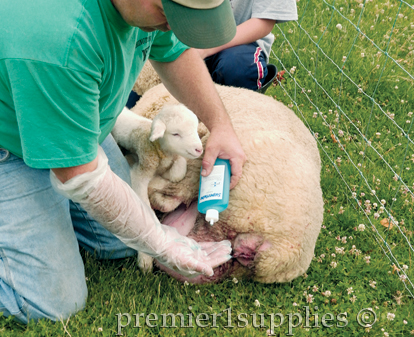
Green grass seems a long time away for some but it will be here before we know it (hopefully). Gordon (a Premier consultant) is spreading SuperLube on OB Gloves in preparation for assisting a ewe during birth.
Premier's
Lambing Supplies Check List
During lambing season we keep a few totes of lambing supplies in the lambing barn. This saves us several back and forth trips between the barn and the "mudroom." The following list will cover general lambing supplies. If you have any questions regarding vaccinations, treatments or procedures please consult your veterinarian.
For indoor lambing:
|
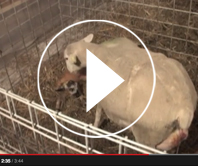
Our photographer shot this video last spring in our lambing barn. It's one of our hair-cross ewes giving birth in a lambing jug.
|
|
|
|